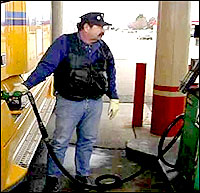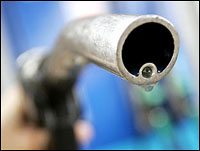| Home ::: FPC Products ::: How & Why It Works ::: FAQ ::: Testimonials |
The BIG Question ... Are you ready to make your fuel dollar go further?One 8 oz. bottle treats 320 gallons of fuel and one case (six bottles) treats 1,920 gallons.
Improves Engine Performance Reduces Oil Contaminants
DocumentationMSDS (pdf)
|
Frequently Asked Questions
Does FPC help with the problems experienced by the reduction of sulfur in diesel fuels? Answer: The problems reported by the reduction of sulfur in diesel fuels relate to the effects on rubber components like o-rings and gaskets, etc. The ULSD (ultra low sulfur diesel) tends to remove the oils from the O-rings thereby making them brittle. This hardening of the O-ring reduces its sealing capabilities and over time it will fail. FPC does not have any sulfur components but it does have components to increase lubricity in the fuel. As explained in TB-1006 the sulfur content is being reduced from about 500 ppm to 15 ppm. The addition of FPC will add only about 100 ppm of our lubricity agent. While this will certainly help, I am not certain it will solve all the problems. A review of the technical literature points to the addition of about 2% biodiesel to the fuel supply which replaces the lubricity lost by the removal of the sulfur. Studies have shown this to drastically reduce the failure of rubber components. The long term cure is to replace these failing components with Viton components. Since Viton is not susceptible to the lower lubricity it is immune to the ULSD. Until that can be accomplished the best course might be to use FPC for increased fuel economy and 2% biodiesel for lubricity replacement. Can FPC be used with biodiesel fuels? Answer: Yes, FPC can be used with any hydrocarbon fuel. The thermodynamic function of the combustion process is to break carbon-carbon and carbon-hydrogen bonds and form carbon-oxygen and hydrogen-oxygen bonds. The difference between the energy of formation of these two states is the net energy (BTU’s) released in the combustion process. FPC is a catalytic agent which works to improve this transformation resulting in fewer unburned or incompletely burned products and more BTU’s generated. This gives rise to the improvements in fuel economy experienced by the use of FPC. These reactions can occur on any hydrocarbon fuel, petroleum based or bio based. What are the benefits of using FPC? Answer: The benefits of FPC are three fold; therefore, you save money three ways at once:
Is FPC like other fuel treatments? Answer: No - 98% of these treatments are solvents. A solvent is an organic product that is consumed during use. However, to appreciate FPC you must understand the dynamics of the combustion process. The combustion process, within any internal combustion engine, utilizes (i.e., burns) a hydrocarbon fuel to create energy. However, combustion is somewhat inefficient and results in the creation of unburned and partially burned byproducts. These byproducts form a sticky layer on the cylinder and pistons which build up over time causing inefficient combustion. This sticky layer is composed of Carbon (C), Nitrogen (N), Oxygen (O2) and Hydro Carbons (HC) and Sulphur. A solvent simply dissolves the surface of this sticky layer and expels it out of the engine. However, a catalyst is different from a solvent in that a catalyst, by definition, must contain a metallic component. Furthermore, a catalyst, since it contains a metallic component, will not be consumed during the combustion process. FPC is an organo-metallic compound which catalyzes the combustion reaction and causes it to burn more completely. How Does FPC Work? Answer: All combustion engines convert BTU’s (British Thermal Units) into torque. This is accomplished by breaking carbon-hydrogen and carbon-carbon bonds and forming carbon-oxygen and hydrogen-oxygen bonds. The net result of this is the heat (BTU’s) available for conversion into torque. This is an exothermic reaction. This reaction is inefficient and results in the creation of byproducts such as carbon monoxide (CO), soot (C) and hydrocarbons (HC). However, all three of these exhaust impurities have a residual energy value. These are unutilized impurities that are exploited by FPC, thus yielding an increase in engine power and reduction in engine emissions. I understand how I will save fuel; but, how will FPC increase the life of my engine? Answer: Carbon is the bane of all combustion engines. Carbon deposits grind away at the inside of the engine causing engine wear and a decrease in the life span of the engine. Carbon deposits are created as a byproduct of incomplete combustion. There is an oil film barrier between moving engine parts. However, if the carbon deposit is larger than the barrier thickness a scouring effect occurs. This wears away at the engine components and the results are seen in the oil analysis. Oil analysis is a traditional way to determine the amount of wear on engine parts. On the other hand, if the carbon deposit is smaller than the oil film barrier the deposit will not cause any wear of engine parts. Indeed tests have shown that the use of FPC reduces engine wear and the results are seen in the analysis of oil samples taken over time. The metals content of oil samples are much lower with the use of FPC and therefore engine life is extended. I’m sold, I would like to use FTP; however, I don’t have an employee to always fill my tank. What should I do? Answer: We have a number of answers to address that concern. The possibilities range from supplying product in containers designed to treat the contents of an entire tanker of fuel so that there is no need for measurement of the FPC to automated dosing equipment designed to automatically dispense the correct amount of FPC after every fill up. The range of possibilities in between includes contracting with the fuel supplier to add the FPC in each load of fuel delivered, automated dosing equipment that reads the flow rate of fuel being off loaded into bulk storage and dispensing the correct amount of FPC according to the blend ratio or automatic dosing systems for individual equipment that will determine the fuel added by reading the fuel tank float and dispensing the FPC correctly. Whatever your needs are we have or can design a system to fit your situation. MSDS: Download the MSDS by clicking here. (pdf) |
Contact Mark Elkin Toll Free 1.901.283.0710
© 2007 FPC Global. All rights reserved.
a MARK 3 PRINTING website. Contact MARK 3 for all of your PRINTING and WEBSITE needs.
powered by Astonished Man

